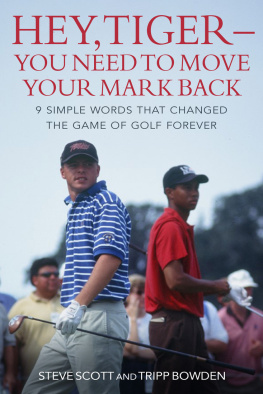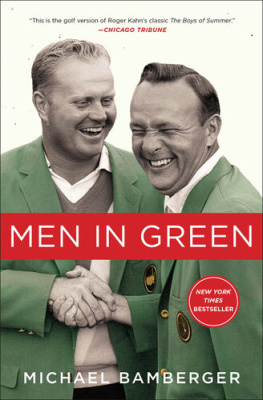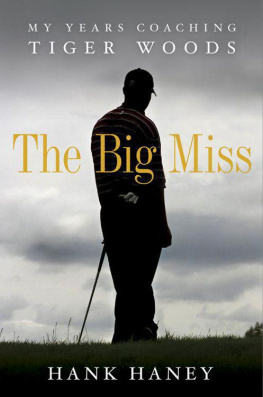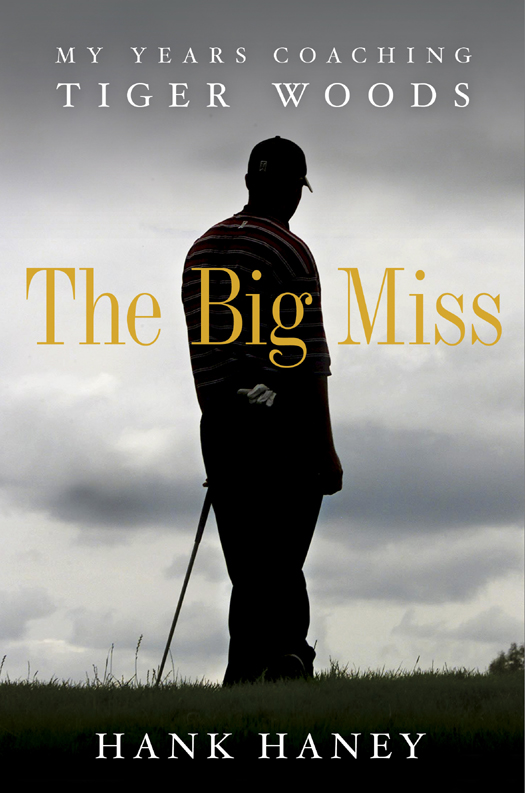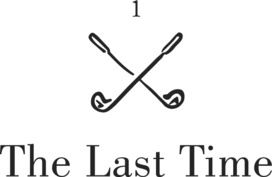Copyright 2012 by Hank Haney
All rights reserved.
Published in the United States by Crown Archetype, an imprint of the Crown Publishing Group, a division of Random House, Inc., New York.
www.crownpublishing.com
Crown Archetype with colophon is a trademark of Random House, Inc.
Cataloging-in-Publication Data is on file with the Library of Congress.
eISBN: 978-0-307-98599-6
Jacket design: Michael Nagin
Front-cover photograph: Timothy A. Clary/AFP/Getty Images
v3.1_r1
To my loving wife, Suzanne
CONTENTS
Tiger Woodss Worldwide Performance Record While
Hank Haney Was His Coach
Finally, a moment of truth.
Less than an hour before hell tee off in the final round of the 2010 Masters, Tiger Woods walks onto the far corner of the Augusta Nationals vast practice range.
The other players and caddies sneak looks. A cheer rises from the packed grandstands, and the rowdier people squeezed together behind the green gallery ropes yell encouragement from short range. Go, Tiger! Youre the man! He might be disgraced, he might be a punch line, but hes still iconic.
As he puts on his glove, the force of the collective gaze that always makes me feel uncomfortable when Im walking with Tiger at a major championship is more penetrating. Hes become more than just the greatest player alive. Hes the human being whos fallen farther faster than anyone else in history. The haters, the sympathizers, the commentatorseveryonewant to see what its done to him.
So do I. Yes, hes been different since returning from an addiction-treatment facility six weeks agomore subdued, possibly shell-shockedbut Ive been waiting to judge whether hes changed as a golfer. Tiger has always been able to go to a special place mentally in the majors, and Im eager to find out if he still can. Will he still be Tiger Woods? Passing golfs excruciating Sunday tests has always been what he does best. But this one feels most like a reckoning.
Tiger is in third place, four strokes behind Lee Westwood and three behind Phil Mickelson. Without saying sohes said little about anything all weekhe knows that a good round today will regain him respect. And its in the air that a victory would be even bigger than the 2008 U.S. Open at Torrey Pines, when he won on a broken leg; finishing on top here might legitimately be judged the most dramatic win in golf history. It would mean redemption, a goal that suddenly seems more important than surpassing Jack Nicklauss record of 18 major championships.
Now its go time. Tigers Sunday warm-ups are traditionally works of art, especially when hes in contention. After three competitive rounds, hes usually distilled what is working to its essence, and using a mix of adrenaline and focus, he can go through the whole bag without missing a shot. Despite having watched Tiger hit thousands of balls, I still feel that thrill that comes with seeing him with full command at close quarters. His swing begins with serene poise at address, continues with a smooth gathering of power, and then, with the coordinated explosion that announces a supreme athlete, uncoils in a marriage of speed and control, the ball seemingly collected more than hit by the clubface. As he relaxes into his balanced finish, the look Tiger gets on his face as he watches his ball fly is more peaceful than at any other moment.
But something is wrong. After a few balls, I can see Tiger is strangely detached. Hes taking too little time between swings, barely watching where the balls go, sometimes even taking one hand off the club before completing his follow-through. The flush yet cracking sound of his impact that for years has announced his superiority over other players isnt quite the same. Hes having a terrible warm-up, almost as if hes not really trying. Other than a few quick grimaces of disgust, his face remains eerily stoic.
Im about ten feet away, standing behind him along his target line, checking to see if his club shaft is on plane, marking his head movement, assessing the ball flight, weighing whether to say something or continue to stay quiet. Its what Ive done as his coach during countless practice sessions over the past six years, but hes acting as if Im not there. I wait for some eye contact from Tiger, some words beyond a mumble, some sense of partnership in this warm-up and this moment. I get nothing. Since emerging from his meal in the clubhouse, hes switched on that cold-blooded ability to leave a personeven someone close to himhanging. Amazingly, right here, right now, Tiger is blowing me off.
This is the treatment. I got my initiation the second time I ever officially worked with him, on the practice range at Isleworth in March 2004. Id stood my ground then, and Im standing my ground now. Tiger doesnt respond well when underlings ask him if somethings wrong, or worse, when theyve done something wrong. His longtime but now former trainer, Keith Kleven, was always fretting about whether Tiger was mad at him. Rather than taking Keiths concern as a show of loyalty, Tiger saw weakness. In his world of testosterone-fueled heroics and military hardness, thats unacceptable.
Hes never done this at a major championship when hes been in contention, so Im not sure what hes thinking. My best guess is that hes carried over his aggravation from the night before, when the raw numbers on the scoreboard forced a realization that winning will be a long shot. Hes probably telling me in a passive-aggressive way that he doesnt like the golf swing Ive given him for this week. His swing problems could also be attributable to pain in his chronically injured left knee or some other body part, but he hasnt complained about anything like that all week. Ultimately, there may be a far simpler reason for the chill Im feeling from him: Hes firing me in the nonconfrontational way thats more common to a breakup than a professional relationship.
Whatever is going on, I know one thing: Hes not going to explain.
I react clinically. Tiger is Tiger, in all his complexities, and my job is to adjust and adapt to him and keep finding ways to get his best. Thats always been a lot harder to do than people think. It turned out to be a lot harder than I thought. But since hes returned from the Mississippi clinic where he followed a psychologically brutal program of self-examination, its gotten harder still.
Hes playing in this Masters after his most rushed, most erratic, and poorest preparation for a major championship ever. Five days before the first round, his game was so ragged it forced me to suggest a limited swing that has cost him distance and shot-making versatility but kept his misses playable.
Its been a theme of my work with Tiger for much of our time together. Although its commonly thought that Tiger plays go-for-broke golf and tries the most difficult shots with no fear, its a false image. Tiger is, above all, a calculating golfer who plays percentages and makes sure to err on the safe side. What he abhors, and has built his career on avoiding, are the kinds of mistakes that produce bogeys or worse and kill both momentum and confidencewild tee shots that produce penalty strokes, loose approaches that leave no chance to save par, blown short putts. These blunders are the stuff of high scores, and after such a round, a tour player or caddie will often lament the big miss. Avoiding the big miss was a big part of what made Ben Hogan and Jack Nicklaus so great, and its a style that Tiger has emulated. Until recently, his entire life seemed free of the big miss. But things change.


